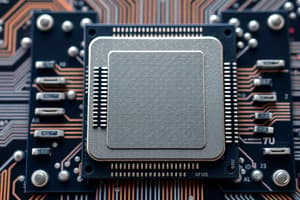Podcast
Questions and Answers
Which component performs the sequence of operations to process data within the CPU?
Which component performs the sequence of operations to process data within the CPU?
- Register File
- Control Unit (correct)
- Memory Management Unit
- ALU
What does the Memory Data Register (MDR) specifically hold?
What does the Memory Data Register (MDR) specifically hold?
- The address of the next operation to be executed
- Control signals for managing data flow
- Data being transferred to or from memory (correct)
- Instruction set for high-level programming
What are the five main functional units of a digital computer?
What are the five main functional units of a digital computer?
- Input unit, Memory unit, Arithmetic and logic unit, Output unit, Control unit (correct)
- Input unit, Output unit, Arithmetic unit, Storage unit, Control unit
- Input unit, Output unit, Control unit, Storage unit, Processing unit
- Input unit, Memory unit, Processing unit, Display unit, Control unit
Which type of bus carries addresses related to data between the CPU and memory?
Which type of bus carries addresses related to data between the CPU and memory?
What is the primary function of the Arithmetic and Logic Unit (ALU)?
What is the primary function of the Arithmetic and Logic Unit (ALU)?
What distinguishes zero-address instructions from other instruction types?
What distinguishes zero-address instructions from other instruction types?
Which of the following is NOT a type of memory?
Which of the following is NOT a type of memory?
In the Von Neumann architecture, what is stored in the same memory?
In the Von Neumann architecture, what is stored in the same memory?
Which type of data is primarily handled by the Arithmetic Logic Unit (ALU)?
Which type of data is primarily handled by the Arithmetic Logic Unit (ALU)?
In programming, what is the role of an assembler?
In programming, what is the role of an assembler?
What does the Control Unit do in a computer system?
What does the Control Unit do in a computer system?
What is a characteristic feature of high-level programming languages?
What is a characteristic feature of high-level programming languages?
Which type of memory allows for random access?
Which type of memory allows for random access?
Which of the following best describes what a machine instruction is?
Which of the following best describes what a machine instruction is?
What is the function of the Program Counter (PC) in the CPU?
What is the function of the Program Counter (PC) in the CPU?
What is the main difference between assembly language and high-level language?
What is the main difference between assembly language and high-level language?
Flashcards are hidden until you start studying
Study Notes
Functional Units of a Digital Computer
- Input unit receives data and instructions for processing.
- Storage unit retains data temporarily or permanently.
- Processing unit (Arithmetic and Logic Unit - ALU) performs calculations and logical operations.
- Control unit orchestrates the activities of the computer's components.
- Output unit delivers the processed results to the user.
Arithmetic and Logic Unit (ALU)
- Primary function is to execute arithmetic and logic operations, such as addition and comparisons.
Types of Memory
- Cache memory improves data retrieval speed by storing frequently accessed data.
- Primary memory (e.g., RAM) allows quick access and temporary storage of data.
- Secondary storage refers to permanent data storage, such as hard drives.
- Tertiary memory is not classified as a standard type of computer memory.
Von Neumann Architecture
- Combines storage for both data and instructions in the same memory space, facilitating processing.
Control Unit Functions
- Coordinates operations of the computer's units to ensure smooth execution of instructions.
Types of Memory Access
- RAM (Random Access Memory) permits data to be read and written in any order.
- Cache memory enhances performance by holding frequently accessed data for quicker processing.
Program Counter (PC)
- Keeps track of the address of the next instruction to be executed in the sequence.
Assembly Language vs. High-Level Language
- Assembly language is machine dependent, closely tied to computer architecture.
- High-level languages are more abstract and user-friendly, designed to make programming easier without needing to understand hardware details.
Instruction Characteristics
- Three-address instruction includes three operands (e.g., “ADD A, B, C”).
- One-address instruction typically uses an accumulator for one of its operands.
- Zero-address instructions operate on a stack structure, not requiring operand addresses.
Fetch-Decode-Execute Cycle
- Describes the sequence of operations (fetching, decoding, and executing instructions) performed by the CPU.
Address Bus Function
- Carries memory addresses between processor and memory, enabling the CPU to access data locations.
ALU Data Types
- ALU works on various data types, primarily numeric, logical, and occasionally text data.
Addressing Modes
- Common addressing modes include immediate, direct, and indirect addressing.
- Sequential addressing is not recognized as a standard type.
Assembler Role
- Converts assembly language into machine code, allowing instructions to be executed by the CPU.
High-Level Languages Characteristics
- High-level languages are user-friendly, abstracting away hardware details and promoting code portability across different computer architectures.
Accumulator (AC) Register
- Stores intermediate results of operations and facilitates data transfer between CPU and memory.
Machine Instruction Definition
- Machine instructions are encoded in binary format, allowing direct execution by the CPU without interpretation.
Studying That Suits You
Use AI to generate personalized quizzes and flashcards to suit your learning preferences.



